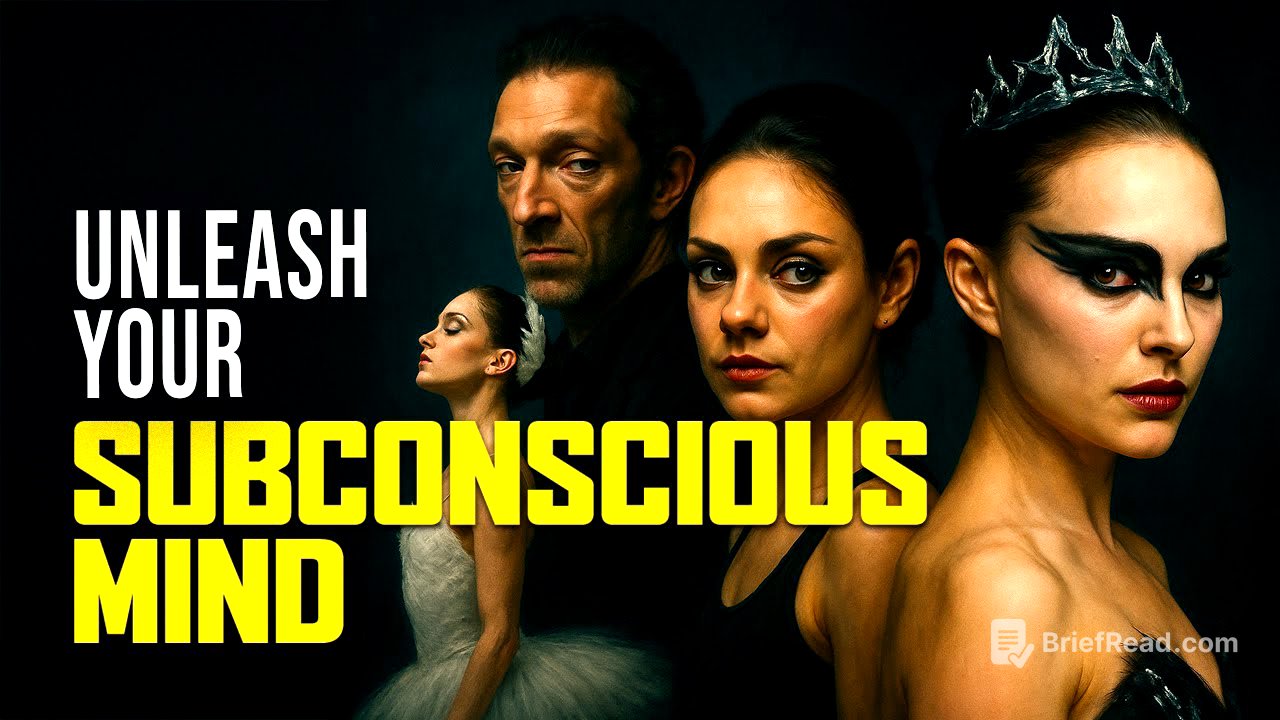TLDR;
This video explores Carl Jung's concept of the Shadow and how it's depicted in the movie "Black Swan." It explains how repressed aspects of our personality form the Shadow, influencing our behavior and hindering our wholeness. The video also discusses family shadows, shadow projections, and provides practical steps for shadow work, such as identifying projections, challenging the inner critic, and expressing the Shadow creatively. The video concludes with an analysis of the movie's ending, interpreting it as Nina's journey towards integrating her light and shadow aspects to achieve wholeness.
- The Shadow is formed by repressed aspects of our personality.
- "Black Swan" is used as an allegory for facing the Shadow.
- Shadow work involves identifying projections, challenging the inner critic, and creative expression.
- Integrating the Shadow leads to wholeness and authenticity.
The Shadow and your inner gold [0:00]
The video introduces the concept of the Shadow, stating that facing the darkest parts of oneself leads to discovering inner potential. Carl Jung's insights on Shadow work are highlighted, and the movie "Black Swan" is presented as a powerful illustration of this concept. The film is described as an allegory for confronting the Shadow, exploring the duality of human nature, and integrating these aspects of oneself.
Black Swan: the story of Nina Sayers [0:40]
Nina Sayers, a dancer in the New York City Ballet Company, wins the lead role in "Swan Lake." The original "Swan Lake" story involves Princess Odette, who is transformed into a white swan by an evil sorcerer named Rothbart. The curse can only be broken if someone who has never loved before swears to love her forever. A prince falls in love with Odette, but Rothbart deceives him with his daughter Odile, the Black Swan. Odette, facing a life trapped as a swan, throws herself off a cliff, ascends to the heavens, and breaks the spell.
Black Swan’s opening dream sequence [2:12]
The opening scene of "Black Swan" shows Nina in a dream, standing in the shadows and approached by a dark figure who transforms into Rothbart, turning her into the White Swan. This dream foreshadows her winning the lead role in "Swan Lake" and symbolizes her unconsciousness of important aspects of her being that are beginning to surface. Nina's childlike room and her mother's overbearing care highlight her arrested development.
What is the Shadow? Carl Jung’s shadow concept [3:33]
The Shadow consists of the parts of ourselves that we reject and hide due to social conditioning. We are taught to divide the world into what is socially acceptable and what is not, repressing certain aspects into the subconscious mind. The persona is the social mask we wear to feel safe and accepted. This division into ego and Shadow leads to a loss of wholeness. Nina's persona is tied to being a perfect ballet dancer, constantly trying to please others and denying parts of her personality. The ballet director, Tomah, notes that she embodies the White Swan but struggles with the Black Swan. Repressing the Shadow requires significant energy, sacrificing authenticity and joy, while the Shadow holds potential power and vitality.
The Family Shadow? [5:43]
Unconscious patterns and repressed aspects can be passed down through generations, forming a family Shadow. Children absorb these hidden worries and unfulfilled wishes, even if unspoken. Nina carries the burden of her family's Shadow, as her mother, Erica, a former ballet dancer, had to give up her career when she became pregnant with Nina. Erica's Shadow carries messages of distrust and overprotection. Although Erica is consciously proud of Nina's success, she is unconsciously jealous. Nina feels pressured to please her mother and carries the burden of her mother's unlived life, trapping her in the persona of an obedient daughter.
When the Shadow takes over [8:01]
As Nina hides so much of herself, her Shadow begins to surface. The psyche is like a seesaw, with the subconscious Shadow on one side and the ego on the other. Culture conditions us to hide shameful parts of ourselves, pushing aggression, envy, and resentment into the subconscious. If too much is pushed into the subconscious, the seesaw flips, and the Shadow takes over. As her Shadow takes control, Nina becomes more rebellious, going out for drinks and partying, which is out of character for her. Her mother expresses concern, and Nina experiences a surreal scene, possibly transforming into a Black Swan.
Carl Jung’s tension of the opposites [10:20]
To resolve the imbalance caused by the Shadow taking over, the seesaw must be brought back into balance by making the unconscious parts of the Shadow consciously aware. Otherwise, the same patterns will be repeated. In a divisive culture, people often flip between extremes, from Shadow to ego and back again, without finding inner peace. To break this cycle, one must hold the tension of the opposites, understanding that the ego and the Shadow come from the same source. Light cannot exist without darkness, and vice versa. Embracing both sides of ourselves is crucial for development.
Shadow Work: 3 key basics [11:08]
Shadow work is the conscious process of reclaiming rejected aspects of ourselves and facing illusions. There are no easy answers, and each person's journey is unique. The first step is to identify Shadow projections, which occur when we see in others the qualities we deny in ourselves. Mirrors are a significant symbol in "Black Swan," representing both the ideal versions of ourselves and our flaws. When Nina's Shadow takes over, her reflection takes on a life of its own. Nina is threatened by Lily, who embodies the qualities of the Black Swan, but she doesn't realize she possesses these qualities herself.
It's hard to know when we're projecting, but a good guideline is that if something informs you, you're probably not projecting, but if something affects you emotionally, you probably are. Keeping a journal to note strong emotional reactions can help identify projections. Paying attention to our critical inner voice can also point to the Shadow. Nina harshly judges herself, striving for unattainable perfection. Recognize that these thoughts aren't who you are and answer with compassion. Expressing the Shadow creatively, as artists do, can provide an outlet. Recapturing a sense of play and curiosity can make the Shadow more conscious and reveal the unlived life within.
Black Swan’s Ending: What it all meant [16:24]
In the final dance, Nina dances the role of Odette, and Lily transforms into Nina's double. Nina fights with Lily in the dressing room, but it's revealed that she was fighting herself, representing the inner conflict between her ego and Shadow. The hostility and jealousy she saw in others were Shadow projections. Nina goes on stage to dance the final act and jumps off the platform, like Odette in "Swan Lake." The movie ends with a fade to white, suggesting a new beginning and transcendence. By understanding both light and Shadow, Nina becomes whole. Her unconsciousness of her Shadow was a spell that kept her from living authentically, but the spell is broken.









![Notion Tutorial - Full Course for Beginners [2025]](https://wm-img.halpindev.com/p-briefread_c-10_b-10/urlb/aHR0cDovL2ltZy55b3V0dWJlLmNvbS92aS9rT2YzUVNCVjI5WS9ocWRlZmF1bHQuanBn.jpg)